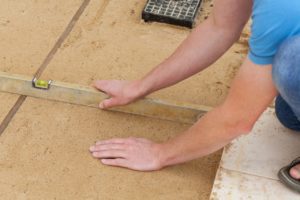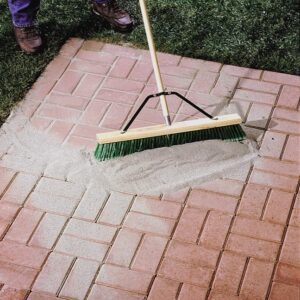Although using pavers to embellish your outdoor area is a great choice for its beauty and simplicity, there are a few details of the paver installation and maintenance process that can be confusing to homeowners. We believe choosing the right sand for paver joints to be one of them.
How many types of joint sand are there? Do they need replacing? How will my choice impact future maintenance? Can I stop weeds from growing if I choose the right sand? Should I refill my existing sand, or change it?
In this article, we will tackle all those questions to help you make the right call when choosing sand for your paver project.
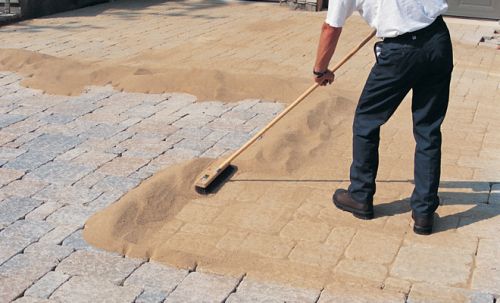
Jump to:
Sand for Paver Joints: Their Importance in Paver Projects
One of the reasons this can get confusing is that sand is a very important product in paver projects, and it’s got two applications. You see, we use sand to create the bedding in which your pavers lie – where it will work as a “cushion” to distribute loads and maintain leveling.
On the other hand, sand for paver joints is used in order to keep the interlocking pattern (ensuring pavers won’t move), stop water from washing away the base layer, keep insects out, and prevent weeds from growing in between pavers.
However, while sand is used for both applications, not the same type of sand is ideal for both.
Which type of sand should I choose?
Base-layer sand should be coarse and granular – so that when compacted (which will happen all the time) the edges will grind together, “locking” the layer of sand and thus avoiding erosion and movement.
When choosing sand for paver joints, your main concern is that it performs as a film, stopping water from flowing down and weeds from going through. Most importantly, you expect joint sand not to wash away with the wind and eventual rain, so you won’t have to keep refilling it. With that goal in mind, finer sands will perform better.
Now that you have a better notion of what you’re looking for and why it’s important, let’s review the types of sand commonly used for paver joint applications below.
Types of Sand for Paver Joints
All types of sand can be used in between pavers; nevertheless, the fact is they will not all perform the same. So, in our quest to find which sand is best for paver joints, let’s go through the 3 main types on the market.
Washed Concrete Sand
Washed concrete sand is composed of larger particles, and it’s recommended and commonly used on the base layers. Some contractors may choose to use it as well as joint sand to save on costs, or simply to avoid working with two different materials altogether.
Although one can claim washed concrete sand helps to achieve a better interlock between the pavers, its larger particles are harder to sweep and compact into joints. As a result, not only it doesn’t seal properly, but it’s also washed away easily.
Mason’s Sand
Commonly seen as the regular sand to use on paver joints, its finer particles create a tighter, less permeable layer that won’t be washed away that easily.
Nevertheless, you will still have to check your paver regularly to identify when it’s time to refill it. Some binding products have been created in order to ensure Mason’s Sand remains in place for longer, and that’s something you should definitely check out if you choose to go with it.
Polymeric Sand
Polymeric sand is a product specially developed for paver joints. To ensure the creation of a less permeable, compact, and unwashable sand layer, the material is created in such a way it hardens when wet for the first time.
That said, during application, polymeric sand looks almost the same as normal sand (except that you can buy it colored too). However, after it completely fills your paver joints, and it’s properly wet, it will harden and hopefully stay there for much longer than any other sand.
It goes without saying that polymeric sand is also more expensive, but will it pay off with time?
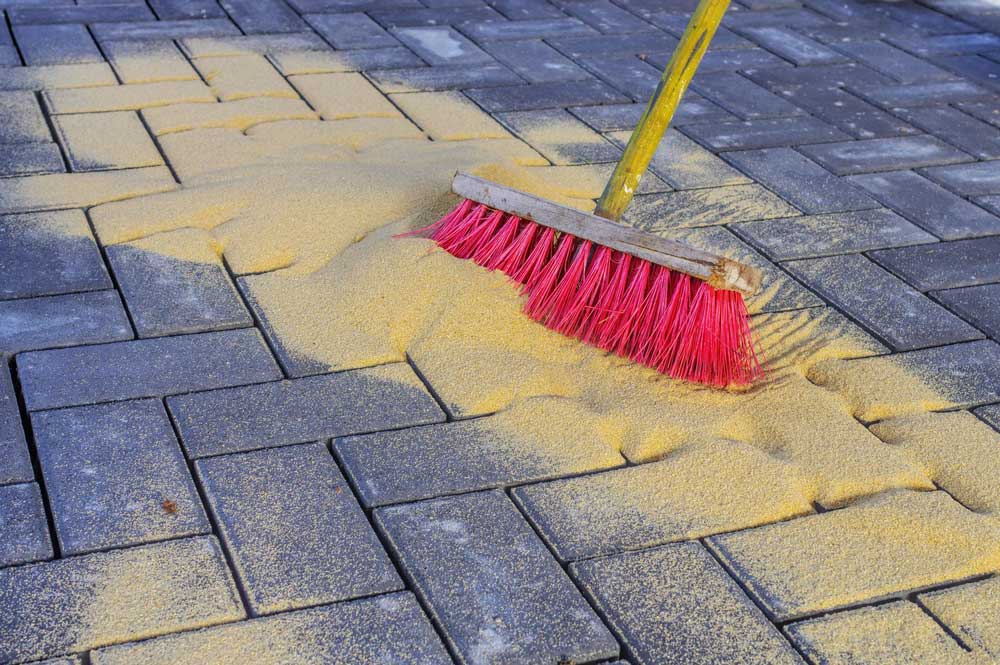
Polymeric Sand is the Best Sand for Paver Joints
Polymeric sand is a specially formulated blend designed to provide optimal performance and durability when used in paving projects.
Unlike traditional sand, polymeric sand contains additives that enhance its adhesive properties and help it to set and lock into place when activated by water. This unique composition ensures a tight bond between pavers, preventing them from shifting or becoming dislodged over time.
When properly installed, polymeric sand creates a solid, stable surface that can withstand the rigors of everyday use and harsh weather conditions. It effectively fills the joints between pavers, inhibiting weed growth and minimizing the infiltration of water, which can cause erosion and destabilization of the paved surface.
One of the key advantages of high-quality polymeric sand is its longevity. Unlike conventional sand, which may need frequent replenishment due to erosion and washout, polymeric sand can last for years without needing replacement.
Despite its resilience, it’s important to keep maintenance up to date, particularly after periods of harsh weather such as hard winters. Refilling the joints with additional polymeric sand helps to replenish any material that may have been lost due to erosion or settling.
Can I Replace Polymeric Sand With Normal Sand for Paver Joints?
No, that won’t be a good idea. The polymeric sand would simply not perform as it should. If your paver joints are filled with normal sand, you should complete them from time to time with normal sand as well.
If you’d like to enjoy the benefits of using polymeric sand, you will have to completely remove the remaining sand from your paver joints, and then fill them with polymeric sand.
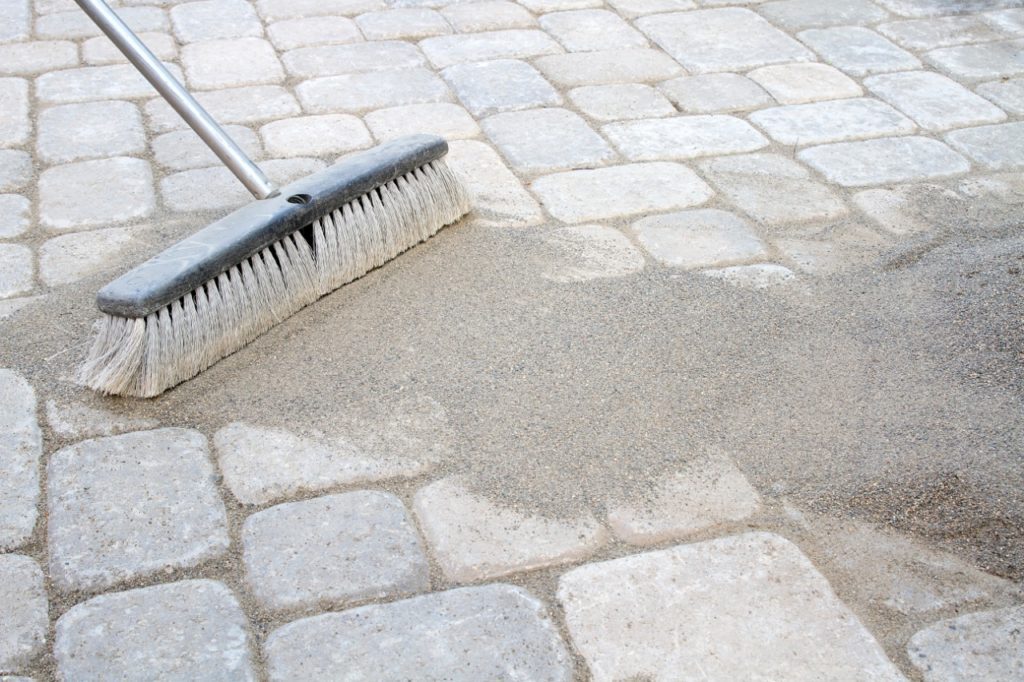
Trust a Professional Contractor to Help You With Paver Projects
Although nothing stops you from doing it all yourself, trusting a good contractor will ensure your installation goes perfectly and your pavers last for longer.
JS Brick has been providing paver supply, installation, and maintenance services for 20 years, servicing Sarasota and all surrounding cities. Don’t hesitate and call us if you need help with your project!
FAQ
You can, but they won’t do the job right. First, they would not contribute to the stability of the interlocked system. Second, they will wash away more easily, which can compromise the structure and cause damage to your installation.
Polymeric sand is still the best choice available.
If you absolutely can’t use polymeric sand, for one reason or another, the best replacement for it is Mason’s sand, also called builder’s sand.
Its particles are much finer and can perform the function better than regular sand would.
It depends on the kind of sand you use. If you go with polymeric sand, a controlled wetting with a garden hose already activates the sand and keeps it in place.
As for regular or mason sand, they will never harden as much as polymeric sand would by adding water. These sands usually set only when you apply the sealer on the installation, one more reason why you should not skip this part.
Yes, but it should be handled with extreme care. Start with the lowest possible pressure setting and from a safe distance from the pavers. If at any point you see sand coming out, stop immediately.
After applying and wetting the polymeric sand, you should wait 24 hours before allowing foot traffic and 48 before vehicular traffic.
In a regular paver installation, with standard-size pavers, polymeric sand is the best option. For permeable installations, a combination of small washed rocks is used to allow for proper drainage. In an installation using large-size pavers, it is common to use patches of grass or rocks in between each paver.
If we’re talking about the installation process, polymeric sand should never be used on rainy days or if the soil is still wet. Polymeric sand should be used only in very dry weather.
As for the project itself, polymeric sand is not required for permeable installations.
Polymeric sand might start to crack if the pavers are moving too much. And if the pavers are moving too much, they are probably not secured enough due to bad bedding or bad installation. We recommend removing the pavers and doing it all over again.
That depends. If the installation is old and polymeric was not used as joint sand, it might help, yes. However, the wobbling of pavers might be a symptom of a larger installation problem. That’s why we always recommend a fresh installation if you’re not sure about its quality. But if you are sure the installation was done correctly, simply re-sanding the installation with polymeric sand can already fix the problem.


